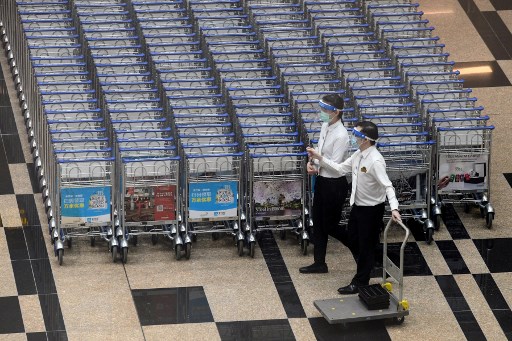What does it mean to study in a foreign country with your family back at home during a global pandemic?
You need to stay on the ball, both near and afar. You want to know what will become of your present and future, while making sure your parents back home are safe and sound.
This is precisely what international students in Singapore have been doing while the Covid-19 crisis has struck at home and abroad in recent months. They religiously read The Straits Times, while keeping one eye on the BBC World Service.
So now, with the lockdown easing and the worst seemingly over, what do they think of the city-state’s Covid-19 measures? The Globe spoke with international students at local universities to find out how the response of the Singaporean government to the Covid-19 crisis, and the city-wide lockdown in recent months, has influenced their perspective on life and governance in the Republic.
Many international students said that prior to the pandemic, the government’s much-reputed efficiency seemed to be mere hearsay – more fact, than fiction. But to some, the pandemic has really showcased what the Singapore government is capable of.
“I have a better image of the government now,” said Richelle, from Nanyang Technological University (NTU). “Before this incident, Singapore was a country without many circumstances to test and see the ability of the government – but because of the Covid-19 outbreak, we saw the government react quickly.”
As early as January 3, the city state started temperature screening at Changi Airport for all inbound travellers from Wuhan, and began to isolate and treat suspected cases with recent travel history to the stricken city. This was only four days after China informed the World Health Organisation on December 31 of mysterious pneumonia cases emerging in Wuhan.
Having confirmed its first infection on January 23, Singapore quickly moved to halt flights from Wuhan, required arrivals to declare their travel history, and imposed Leave of Absence on returnees from China. That was also when the 76-day lockdown in Wuhan started.
Caleigh, from National University Singapore (NUS), praised the government for bringing its citizens abroad back, even as the Covid-19 situation in Singapore began to escalate.
“Previously all the people overseas were helping the situation [in China] and sending back all the resources,” Caleigh said. “It’s a [significant] comparison that China asks people overseas not to come back, while Singapore calls all the people back.”
But Emma from Yale-NUS College was more critical of the response. She believes that the government has been focusing too much on Singapore citizens and permanent residents, and did not pay enough attention to the nearly one million low-wage migrant workers when crafting policies.
“The government was aware of what kind of situation migrant workers live in, but it chose not to do anything, because it has been focusing on the majority,” she said.
Migrant workers’ living conditions have come under the spotlight after their dormitories saw a spike in Covid-19 cases. Up to 20 people can be packed in one room, and a few dozen share the same toilet and dining area, making social distancing practically impossible.
The outbreak in these dorms came despite efforts to improve migrant workers’ living conditions after the 2013 Little India riot, and repeated warnings from rights groups about poor conditions. Now, more people are wondering why the government did not act sooner.
While Shawn, also a student at NTU, agreed that the government should have paid more attention to the foreign workers, he said the pandemic caught the Republic between a rock and a hard place. On the one hand, it is ideal for the government to test and treat as many people as possible. But given limited resources and manpower, the government had to look after its citizens first, Shawn added.
“It is inevitable for governments to react with some exclusiveness when tackling an emergency like the Covid-19,” said Shawn.
As of June 9, migrant worker dorms account for almost 94% of Singapore’s Covid-19 cases.

I’d always thought Singapore was very sure about things … As in, if this is what we ought to do, we should do it. But now, it was more like ‘let’s see what we can do’
“Now we realise migrant workers count, literally,” said Yale-NUS College’s Emma.
A further issue is the timing of the circuit breaker measures, which were only announced on April 3 as Singapore hit 1,114 cases. In comparison, China placed Wuhan in a quarantine on January 23 after clocking 571 cases nationwide, and Malaysia decided to implement the Movement Control Order (MCO) when it recorded 553 cases on March 16.
Wei Xiang from NTU felt that the government’s phased approach to the Covid-19 outbreak was somewhat unexpected. “I’d always thought Singapore was very sure about things,” the Malaysian said. “As in, if this is what we ought to do, we should do it. But now, it was more like ‘let’s see what we can do’.”
While he acknowledged that the government had been proactive to use budgets to take care of its residents, he thought that circuit breaker measures “came too late”, especially when compared to the timing of Malaysia’s partial lockdown.
“A lot of times, to ‘minimise’ disruption is to make greater sacrifices at the start which can safeguard the most in the future,” Wei Xiang argued. “It’s like going through a painful one-hour surgery to prevent 10 hours’ worth of surgery in the future.”
Since the MCO kicked into effect on March 18, Malaysia has seen its Covid-19 cases plateauing, prompting the government to declare the spread contained and loosen the quarantine. Meanwhile, even as Singapore recorded a rise in discharging figures, reaching about 74% of its total infections, the health authorities warned that cases will likely remain high as more migrant workers are being tested and the circuit breaker eases on June 1.
Other than the Republic’s reliance on foreign trade, some Chinese students in Singapore also pointed to the different geographical sizes that make a complete lockdown, as seen in Wuhan, unfeasible.
“It’s a small country, unlike China where you can support one province with medical supplies and personnel from other provinces,” said Emma. When hospitals in Hubei province were flooded with patients, medical practitioners and equipment flew across the country to help tackle the spread at the epicentre of the pandemic.
Wei Xiang still felt that confidence and comfort is partly the reason why the Singapore government can have options and take a gradual approach instead.
“The government could have been more authoritative and forthcoming with their responses,” the Malaysian insisted. “It is not about a question of urgency, but the notion that we can afford to consider the ‘what-if’s’ that has made the problem compound till it is today.”
Sometimes trust can be infantilising … The government tries to calm the public too much that a lot of people are not taking the virus seriously enough
While most international students I spoke to generally approve of the government’s capability to handle the pandemic, some said that the overpowering role of the state has ironically made the community less vigilant.
“Sometimes trust can be infantilising,” said Caleigh from NUS. “The government tries to calm the public too much that a lot of people are not taking the virus seriously enough.”
Caleigh recalled that on January 23, when Singapore confirmed its first, imported case of Covid-19, her Chinese peers were all alarmed. Her WeChat was flooded with posts from panic-stricken Chinese asking for places to buy masks in Singapore. But on her Instagram stories, it was life as normal for her Singaporean friends – party, shop, and watch planes soar and dive at the Singapore Airshow.
“They are obeying the law, yet not fulfilling the intention behind the circuit breaker,” Chloe from NTU commented. At the height of the pandemic, her parents in Jiangxi, China only went out once every 10 days to get groceries.
Emma said the root cause of this phenomenon is Singaporeans’ general trust in the government. “Trust can be good or bad,” she said. “You treat yourself as a child and you don’t realise your own social responsibility.”
Emma argued that Chinese citizens have a much better community response than Singaporeans. Even as her hometown in Fujian has recorded zero Covid-19 cases for about two months now, Emma’s parents still refrain from going out, not even to exercise.
Meanwhile, just a few days after the circuit breaker started, the authorities moved to implement safe distancing more strictly, slapping fines on people gathering in groups or forgetting to wear masks. Indeed, fewer people wandered around outside, cases in the local community started to wane, and the circuit breaker has been relaxed from June 1 onwards.
Singapore will eventually overcome the pandemic, but this episode has prompted us to ask ourselves the hard questions about what constitutes the good aspects of governance in the city-state, and what constitutes the bad.
Zibang Xiao flew from Shantou, China to Singapore to study eight years ago. He has recently graduated from Nanyang Technological University.


